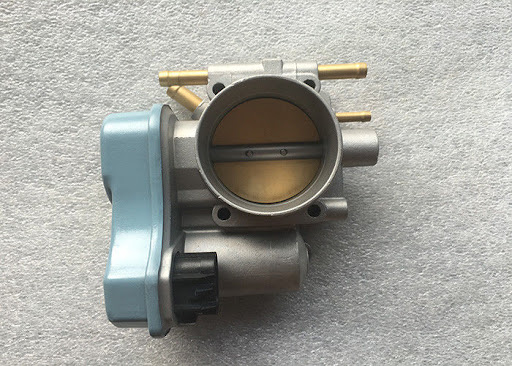In a traditional spark-ignition gasoline engine, the throttle body is part of the intake system and is used to control the amount of air flowing into the engine's combustion chamber. It consists of a housing unit, which contains a throttle plate (butterfly valve) that rotates on an axis.
When the accelerator (gas pedal) is depressed, the throttle plate opens and allows air to enter the engine. When the accelerator pedal is released, the butterfly valve closes and effectively prevents (throttles) the airflow into the combustion chamber. This process effectively controls the speed of the engine and ultimately the speed of the vehicle.

How It Works
The throttle body is usually located between the air filter and the intake manifold and contains a sophisticated throttle valve system that controls the key component of spark ignition: airflow. As part of the atomization process, the airflow helps to adjust the air-fuel mixture ratio required to ignite the engine.
The main regulator of throttle pressure appears in the form of a throttle body temperature sensor, which measures the temperature of the air-fuel mixture entering the automobile fuel injection system. This necessary adjustment helps spark ignition to produce maximum fuel efficiency.
The airflow is mainly controlled by the throttle butterfly valve, and the driver adjusts the airflow by stepping on the accelerator pedal in the car. This reacts to a sensor on the throttle bottle, which tells it to allow more air to enter the combustion chamber, thereby increasing REM and power output. This in turn makes the car run faster.

Common Issues and Solutions
Like every part of a vehicle, the throttle body will eventually wear out. Rarely, you will find that your throttle is completely damaged. However, sometimes the entire throttle system fails and you have to install the entire throttle body replacement, but this actually only happens in high mileage vehicles.
Most commonly, the throttle body temperature sensor is likely to fail first. If you do find yourself experiencing an engine failure, you may need to check the temperature sensor. This is especially true if your vehicle stalls or its performance is poor.

In addition, faulty electrical connections (including faulty radios and dashboard panels) may be the result of a faulty throttle body temperature sensor. If you experience any of these symptoms in a vehicle or the vehicle's inspection engine light turns on, you should visit a local mechanic for a more comprehensive diagnosis. It is harder to find a throttle failure than most mechanical problems.
In order to better protect these important parts of the ignition process, you can consider switching to biofuels, which can reduce the wear of engine components. Or, regular adjustments and maintenance will extend the life of the vehicle.













